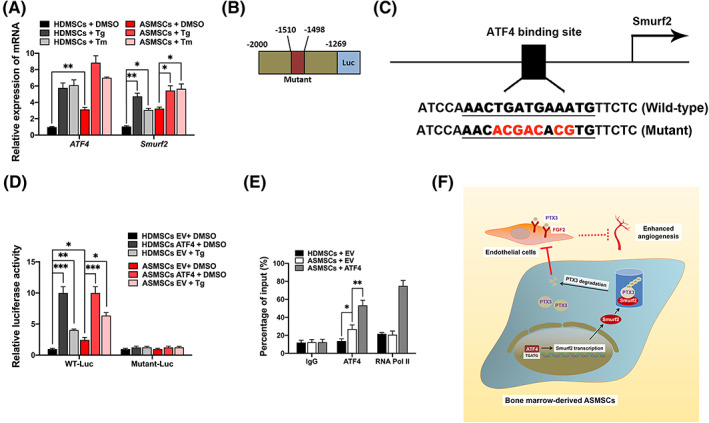FIGURE 7.

Regulation of Smurf2 by ATF4 activation in mesenchymal stem cells (MSCs) in patients with ankylosing spondylitis (ASMSCs). A, The altered cellular response may indicate an increased ability of E3 to ubiquitinate its substrates. 32 Compared to those in MSCs in patients with healthy donors (HDMSCs), the levels of both ATF4 mRNA and protein were increased in ASMSCs. Then, we induced pharmacologic ER stress in MSCs by treating them with tunicamycin (Tm) or thapsigargin (Tg), which are two ATF4 agonists. Smurf2 expression was induced by Tg and Tm in both ASMSCs and HDMSCs (n = 10 different HDMSC or ASMSC lines per group). Therefore, we speculated that Smurf2 might be a molecular target of ATF4. We examined the promoter region of Smurf2 and predicted a potential ATF4‐binding motif in the promoter region of the Smurf2 gene using JASPAR profiles to test this hypothesis. B,C, Schematic of the luciferase reporter plasmid constructs: WT‐Luc and Mutant‐Luc. D, Luciferase reporter assays further showed that ATF4 and Tg increased the transcriptional activity of this promoter; however, mutation of the motif substantially attenuated the transactivation activity of ATF4. E, ChIP assays in MSCs further showed that ATF4 overexpression activated the ATF4 binding site of the Smurf2 gene and promoted Smurf2 transcription (n = 10 different HDMSC or ASMSC lines per group). F, We concluded that Smurf2 transcription is regulated by ATF4‐induced ER stress and that Smurf2 negatively regulates PTX3 stability in ASMSCs and abnormally promotes angiogenesis through the PTX3‐FGF2 axis. All data are presented as the means ± SD. *P < .05, **P < .01, ***P < .001
